Social media is an incredibly powerful form of communication, not only for people to stay in touch online with friends and families but also for businesses just like yours to have a direct line to their customers.
But if you really want to harness the full power that social media can offer, you need to put together a strategy or a plan that will help you through social media marketing.
To help you along, we’ve put together the framework to create a successful social media marketing strategy, plus a few critical reasons why you’d want to.
Get brand new marketing strategies straight to your inbox. 23,739 people already are!
What is Social Media Marketing?
Social media marketing involves using social media platforms – like Facebook, Twitter, Instagram, etc. – as a means of marketing your business and connecting with your audience.
There are 3.6 billion social media users in 2020, a number which is expected to grow to 4.41 billion by 2025, so if you don’t have an online presence, you’re missing out on a great way to connect with your audience.
Objectives for social media marketing typically include building a larger audience, sending traffic to your website, and driving sales.
This type of marketing can be incredibly successful and bring large and small businesses a lot of recognition if you create and execute a unique strategy that really resonates with your audience and makes your brand seem authentic.
The trouble is, however, creating such a strategy. When there are so many ways to make mistakes, how can you be sure that your strategy is a good one, and that you’ll see the results you’re looking for?
We’re going to walk through the many benefits that social media can have for you so that you understand just how important a successful strategy is, then guide you through creating your own.
Top 22 Benefits of Social Media Marketing
Social media marketing has so many benefits that it’s all but imperative for any successful business to have a presence on at least one of the social media platforms.
Learn more about why social media has become so integral for businesses wanting to grow and reach their community.
1. Tell your brand story.
Social media gives you the perfect chance to tell your brand story your way. Use your bio, social media content, brand voice, and personality to present your brand in the way you want it to be perceived.
Create authentic social media and video content that shares your mission and the story behind the brand to help build genuine connections with followers and customers.
2. Create brand recognition.
If you create cohesive social media content that matches your branding, it can help to create brand recognition online. Make sure you brand your social media profiles as well to ensure your presence is recognizable across the board and on any platform.
This includes creating similar looking graphics, profile photos, cover photos, calls to action and more.
3. Keep customers in the know.
Your social media profiles should be one of the first places you share company announcements, new products, services or features, and similar launches. If you’re hiring, share it on social media. If you’re closing for a holiday, share it on social media.
While you always want to be strategic about your social media content, using this platform as a way of notifying customers of any changes is a great way to build trust in your followers.
4. Increase brand awareness.
When your brand posts on social media and engages with your audience, it helps put your brand name in front of a much larger audience.
Additionally, when your followers share your content, they’re introducing your brand to their own followers, leading to increased brand awareness and helping more and more people discovering your business.
5. Build a community.
Social media gives you the perfect opportunity to round up your most loyal customers and audience members and create a community for them.
Whether you simply remain hyper-engaged with your audience on a specific social media platform or you create a social media group, building a community is a great way to improve brand loyalty and get constant customer feedback.
6. Bring in organic traffic.
Social media is an incredible way to bring free, organic traffic to your website. And while social media offers affordable paid options, it’s exciting that this form of marketing can help improve your organic and earned traffic as well.
By creating a successful social media strategy, you can exponentially increase the amount of traffic that your website receives just from social media.
Social media can also help improve your SEO, increasing your rank on Google and other search engines, bringing even more organic traffic to your website.
7. Provide customer service.
Consumers often mention brands online when referring to either a good or bad experience with that company, and it’s your responsibility to monitor and respond to these queries.
Using your social media presence as a customer service platform is a great way to respond to issues as they arise and ensure your audience knows your brand is going to be there for them.
8. Gather social proof.
Whenever customers leave reviews on your Facebook Page or you find positive mentions of your brand online, save that content to share online as social proof.
Positive reviews and social proof make 91% of consumers more likely to buy from your business, so flaunt what you’ve got.
9. Become a thought leader in your industry.
Sharing educational and credible content on your social media platforms can help to position your brand as more of a thought leader in your industry and a trusted source for information.
Not only does this help with word of mouth marketing, but it can also help improve your website’s SEO as more and more sites will start linking to your content as a reliable source.
10. Gain easy access to competitor strategies.
Social media is also an awesome way to scope out the competition and see what they’re up to. Check out your competitor’s social media platforms to see how often they post and what types of content they’re sharing to get ideas for your own strategy.
Platforms like Facebook also offer transparency into your competitors’ ads so that you can get a glimpse at how many ads they’re running and what they’re promoting.
Gathering information on the competition and analyzing how their current strategy works for them is a big part of creating your own strategy, and social media allows you to easily do some valuable recon.
11. Gather customer research.
Keep an eye on your social media insights and analytics to gather demographics about the types of users who are following your brand on social media. You can make sure they’re in line with your target market by double-checking their age, gender, interests, and more.
12. Facilitate conversations around your brand.
When you create engaging content that gets comments, shares, likes, etc., you’re starting to generate buzz around your brand. If you notice that certain types of content generate more interaction than others, you want to make sure to create and share more of those types of posts.
This will start to encourage more responses and mentions of your brand, getting more of your followers – and subsequently their followers – involved in the conversation that’s all about you and your company.
13. Take advantage of social listening.
Social listening allows you to monitor certain topics, hashtags, brand names (namely yours), etc., so that you can keep an eye on what people are saying and if there are ever any conversations you need to respond to related to your brand/industry.
This is a great way to catch any mentions of your brand, but also to find trending topics in your industry, to analyze the types of content your audience likes and shares, and to get a glimpse into how your followers speak on social media.
14. Increase your reach with hashtags.
Be sure to put together a hashtag strategy for your social media content that helps you get your content in front of even more eyes. Hashtags create searchable links and are great keywords to help your content get found by even more viewers.
Tools like Hastagify or RiteTag are helpful for determining the best and most relevant hashtags to include in your tweets and Instagram posts.
You can search for various potential hashtags to see which ones get the most search volume and keep a log of the best options so that you can easily incorporate them into your future social media content.
Twitter, Instagram, and LinkedIn are the best social media platforms to use hashtags on as they’re not as searchable on other platforms like Facebook and Pinterest.
15. Promote your blog content.
While your content marketing strategy should also include a lot of SEO best practices to rank higher in SERPs (search engine results pages) and increase organic traffic, you should also regularly share your blog content on your social media platforms.
Many platforms are powerful when it comes to generating website traffic, so ensuring blog content is a big part of your social sharing calendar is the perfect way to send even more audience members to your website.
16. Improve your link building strategy.
So let’s say you took our advice in the last point and started sharing your blog content on social media. More and more people online come across your blog content, read it and share it, increasing the eyes on your blog even more.
The more people who are introduced to your content, the more likely they are to link to your content, increasing backlinks to your website and improving your SEO all at the same time.
17. Retarget your audience.
Social media ads are a really excellent way to keep your business top of mind for potential customers, namely by creating and executing retargeting campaigns.
Retargeting your audience involves implementing a pixel onto your website that tracks user behavior, then places ads in front of users who have visited your website but haven’t taken action and converted into customers.
These types of campaigns are highly effective as you’re able to gently nudge people in your funnel down to the bottom and compel them to make a purchase.
18. Create viral campaigns.
While it’s important to note that it’s difficult to create viral campaigns – and they don’t always happen on purpose – going viral on social media is still possible and is a great way to create buzz around your brand.
Pay attention to trending topics, things your audience loves, and memes that are relevant to your business to see if you can create a winning social media campaign that gets viral attention and propels your brand forward in recognition and awareness.
19. Easy A/B testing.
Social media is also a great place to test various ideas and messaging points with your audience. Whether you choose to do this via advertising or by testing different content ideas, you can easily pinpoint the more popular post by doing A/B testing on social media.
20. Make sales and boost conversions.
You can also use your social media profiles strategically to make sales and boost conversions, resulting in increased revenue and ROI.
Ecommerce brands and business owners can set up storefronts on social platforms like Facebook, Instagram, and Pinterest to make direct sales, while service-based brands can promote demo videos and sales pages to convert leads and followers.
21. Generate leads.
Sharing lead magnets and sales pages on social media can help to increase the number of leads you’re able to add to your CRM. Whether you choose to share these organically or through paid ads is up to you and what works for your social strategy – more on that in a bit.
22. Social media is free.
The best part of all of this? Social media is completely free! You can do all of this without paying a dime – only some of your time.
While investing in social media ads will also help ramp up your success, you don’t have to pay to use any social media platforms and you can still start to see awesome results as long as you put together and implement the ideal social media strategy.
To help you move forward in your social media success, let’s dive into the steps you need to take to actually create a social media marketing strategy that works.
How to Create a Social Media Strategy
Now here’s the good part – actually putting together your social marketing strategy and getting started promoting your business online.
We’ve put together a quick eight-step process to help you build a successful social media strategy that will work perfectly for your business and industry. Remember that social media marketing is not one-size-fits-all, and your strategy needs to be perfectly suited for your specific brand and needs.
Walkthrough the strategy building process with us.
Step 1: Set SMART goals.
The very first thing you need to do is create clear goals and objectives for your social media strategy.
We like to use the SMART method when building strategies. SMART stands for:
- Specific
- Measurable
- Achievable
- Relevant
- Timely
And while SMART goals can be used across a variety of industries and needs, they also work perfectly when creating clear objectives for the success you want to get out of your social media marketing strategy.
Let’s get a bit more specific about how you can create these goals.
Specific
You want your goals to be as clear-cut as possible. Don’t set a goal for “increasing social media followers.” Which platform(s)? How many more followers do you want? You want your goals to have all the necessary information so you know if/when you’ve achieved them.
When putting together your social media strategy, try to aim for 3-5 clear, specific goals that you’re hoping to work towards in your marketing.
Measurable
It’s also important to be able to measure the success of the goals you’re setting. Instead of having a more abstract goal like, “Increase website traffic,” try adding in a way to measure success by saying, “Increase website traffic by 5% MoM.”
This gives you something that you can actually track to see if you’ve met your goal. Simply working to increase website traffic doesn’t help much if you’re only seeing 100 new visitors a month. Sure, you’ve technically hit your goal, but is that actually going to help your bottom line?
Achievable
This is another essential aspect of your social media goals. Are these goals actually attainable? There’s a big difference between goals that are aggressive and goals that simply aren’t realistic.
For example, if you’ve just recently started your Twitter profile, don’t make it a goal to get 10,000 followers within your first month. Unless you’re lucky enough to have a piece of content go viral, it’s probably not going to happen, no matter how much effort you put in.
Instead, start small, and work towards a percentage increase each month. Make it a goal to hit 100 followers in your first month, then work to increase your follower count from there.
If you’ve had your social media accounts for a while and you’re looking to ramp up your marketing and revamp your strategy, take a look at how your accounts have grown for the past few months to know what a realistic goal for growth might look like for you.
Relevant
Make sure the goals that you set are closely aligned with your business objectives and make sense for your audience.
For example, you don’t want to set a goal of increasing engagement and repins on Pinterest if your audience doesn’t actually use the platform. While you might think you need to focus on every social network, it’s important to only focus on the platforms and tactics that are going to help grow your audience and your business.
Timely
Give every goal you create a deadline. Will you check progress each month? Each quarter? Is this a year-long goal? Creating time-based goals is essential to tracking the success of your social media strategy.
And if one of your goals is a bigger one (i.e., increased revenue over the whole year), be sure to give yourself milestones and dates to check in on your progress to see if you’re on track for hitting your goal or if you need to make some adjustments to your strategy.
Step 2: Create customer personas.
The next step in creating your social media marketing strategy is to create solid customer personas that represent your target audience so that you know exactly who you’re marketing to.
While many marketers have an abstract idea in their minds of who they need to cater their content to, putting together an actual buyer person can give you a much more realistic vision in your mind of who, specifically, you’re trying to resonate with your content with.
Defining your customer personas is also key in determining which social networks you need to focus on most.
There are just a few things you need to pinpoint when creating perfectly targeted customer personas.
Demographics
The first thing you need to pay attention to is the basic demographics of your target audience. What gender do they identify with? What is their age range? Income? Job? Family?
Why is this information so important to have on hand? Well, for example, a marketing SaaS company can have a really ambiguous target audience. While some tend to target marketers, others need to focus more on CEOs and major decision-makers.
It’s essential for everyone on the sales and marketing teams to be 100% on the same page as to which social media users they’re trying to reach with their messaging, and putting together basic demographics is a great start.
Lifestyle
For more B2C brands, you need to have a good idea of the things your audience likes to do and their overall interests, especially when it pertains to your product or service.
This could include hobbies, workout regimen, skincare routines, favorite stores and restaurants, and more.
Buying Motivations & Pain Points
Think about what drives your target audience’s buying decisions. What would be the motivation that would get them to sign up for services or click that check out button?
Furthermore, what pain points or problems do your target market have that your product/service is the solution for?
Talk about how your brand is the answer and how you can further motivate your target audience to take action.
Step 3: Determine which platforms you’ll utilize.
Since you spent some time in the last step researching and pinpointing information about your target customer, it’s the perfect time to figure out which social media channels will work best for your brand.
If you’re not sure where to start, put those demographics you listed to good use and double-check each social media platform’s user demographics.
You also want to consider the type of content your business creates and will be sharing. If your business isn’t super visual, a platform that’s all about aesthetics like Instagram or Pinterest might not be for you.
Let’s cover the top social media sites and why you might choose to have a presence on them or not.
This is the giant. With over 2.7 billion monthly active users – that’s a quarter of the entire world’s population – on Facebook, you’re sure to find at least a segment of your audience on this platform.
Plus, Facebook is the perfect spot to share nearly any type of content – photos, videos, blog posts, podcasts, etc. You can also set up an online shop right on your Facebook Page to further promote and sell products.
[caption id="" align="aligncenter" width="590"]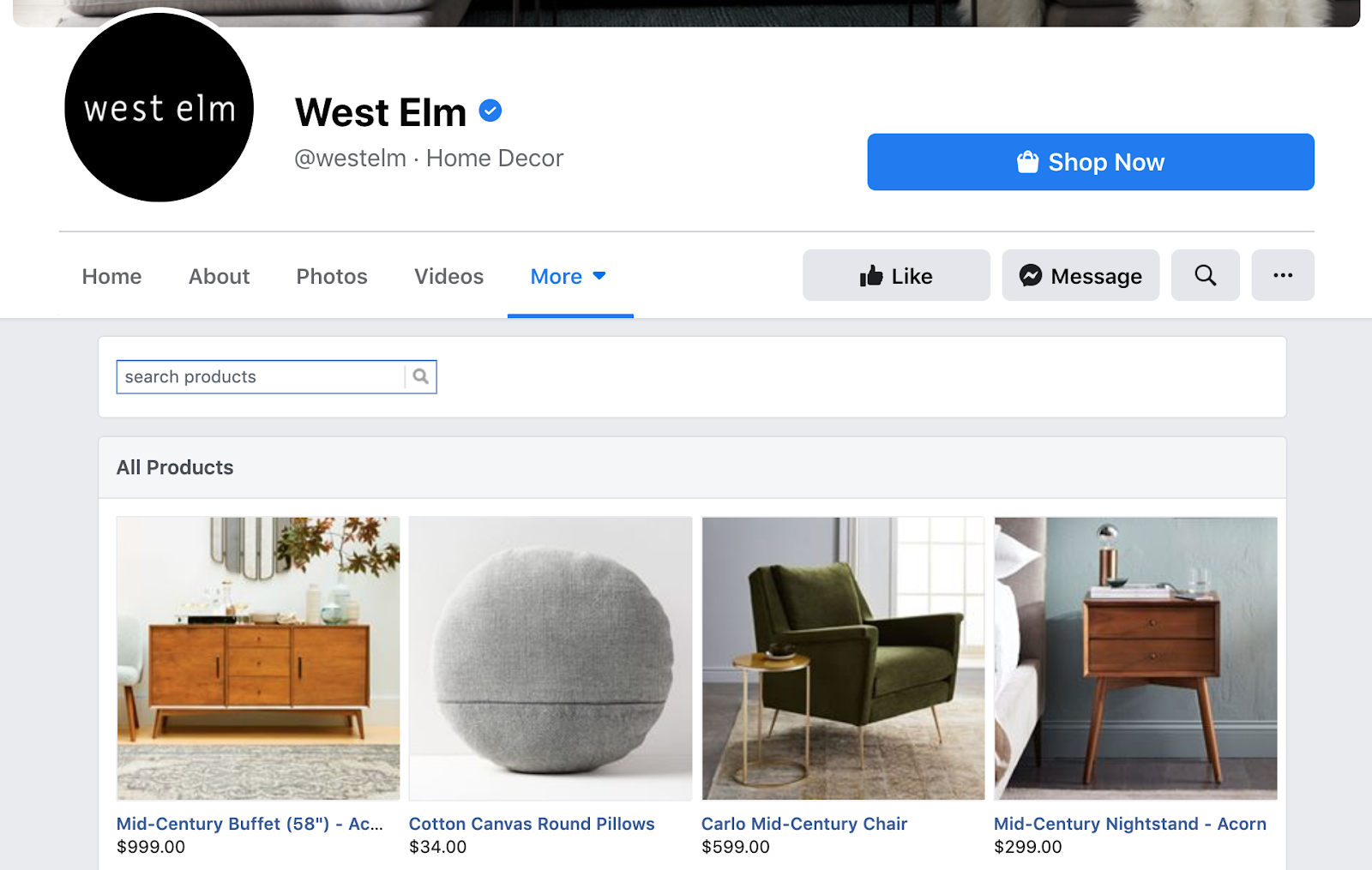 West Elm’s Facebook shop[/caption]
West Elm’s Facebook shop[/caption]And with Facebook ads giving you the perfect advertising platform, you’ll definitely want to create and utilize a Facebook Page for your brand.
While owned by Facebook, Instagram has gained popularity in its own right. The photo-sharing app has turned into a really excellent marketing platform for visual brands and influencers alike.
Instagram boasts over one billion monthly active users taking advantage of their feeds, Stories, IGTV, and brand new Instagram Reels, with many users logging in multiple times a day.
[caption id="" align="aligncenter" width="590"] StoriesEdit’s Instagram feed[/caption]
StoriesEdit’s Instagram feed[/caption]While B2B and service-based brands can still take advantage of Instagram, this platform is more successful for brands who have a clear idea of how to be visual – whether through photos, graphics, etc.
Many millennials utilize this platform for influencer marketing, building an audience and promoting products and services, which can be a great digital marketing strategy for your brand.
In third place, we have Twitter with around 330 million monthly active users. The platform skews more male, with journalists and the tech industry seeing a lot of success through the platform.
While Twitter is another platform that supports all sorts of content, one big thing that brands should have to grab their audience on Twitter is a great brand personality.
If you can incorporate humor and a bit of sass or edginess into your tweets, you’ll likely do very well on Twitter. Brands of note include MoonPie and Fast.
[caption id="" align="aligncenter" width="590"]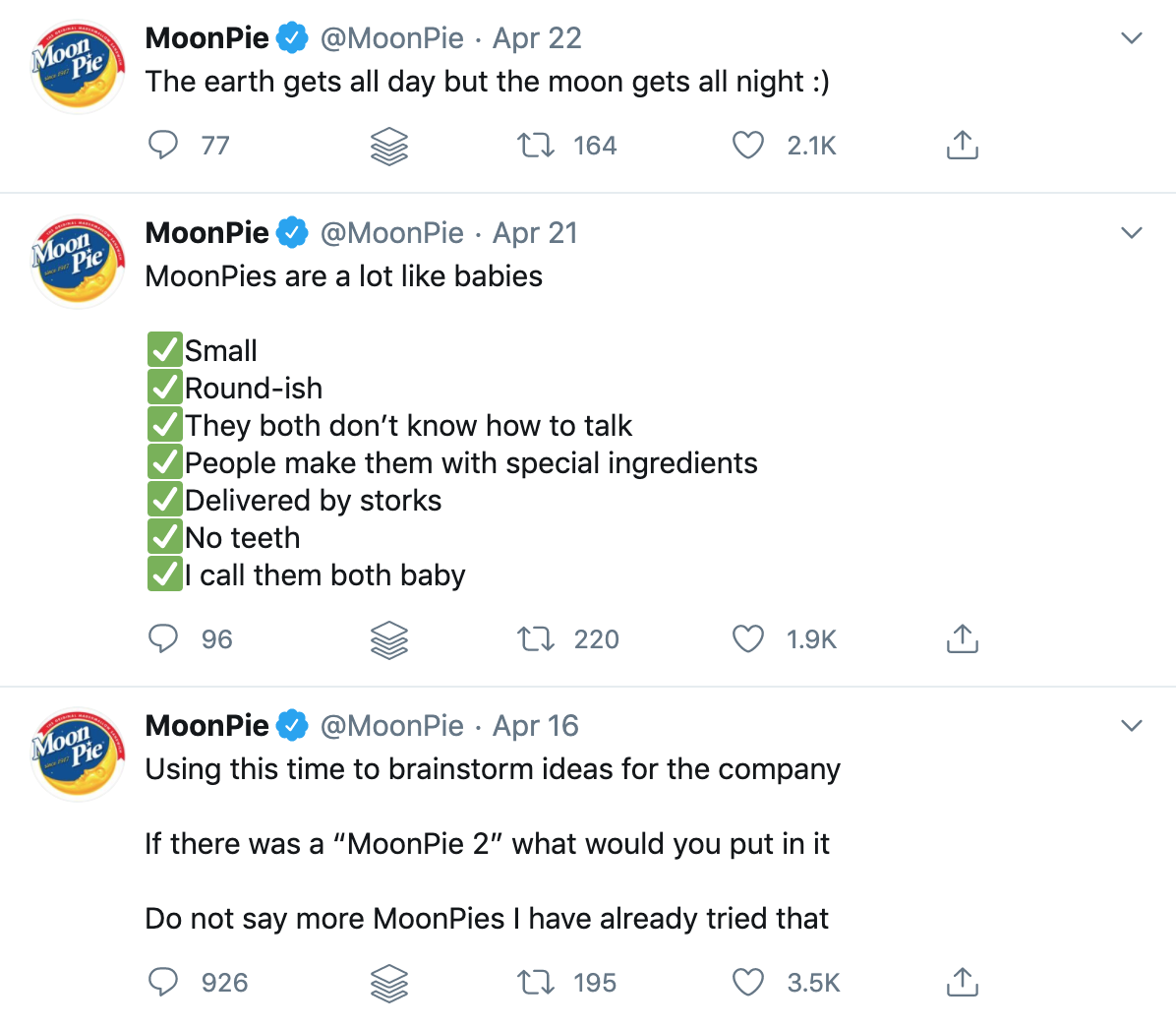 MoonPie’s Twitter feed[/caption]
MoonPie’s Twitter feed[/caption]Because LinkedIn is so powerful for creating professional and business connections, every brand should have some type of presence on this platform.
Not only that, if your business grows big enough to begin hiring, you want a company page that employees can tag in their profiles and recent work.
LinkedIn is obviously ideal for company-related content and announcements, but B2B brands also flourish when marketing on this platform.
[caption id="" align="aligncenter" width="590"]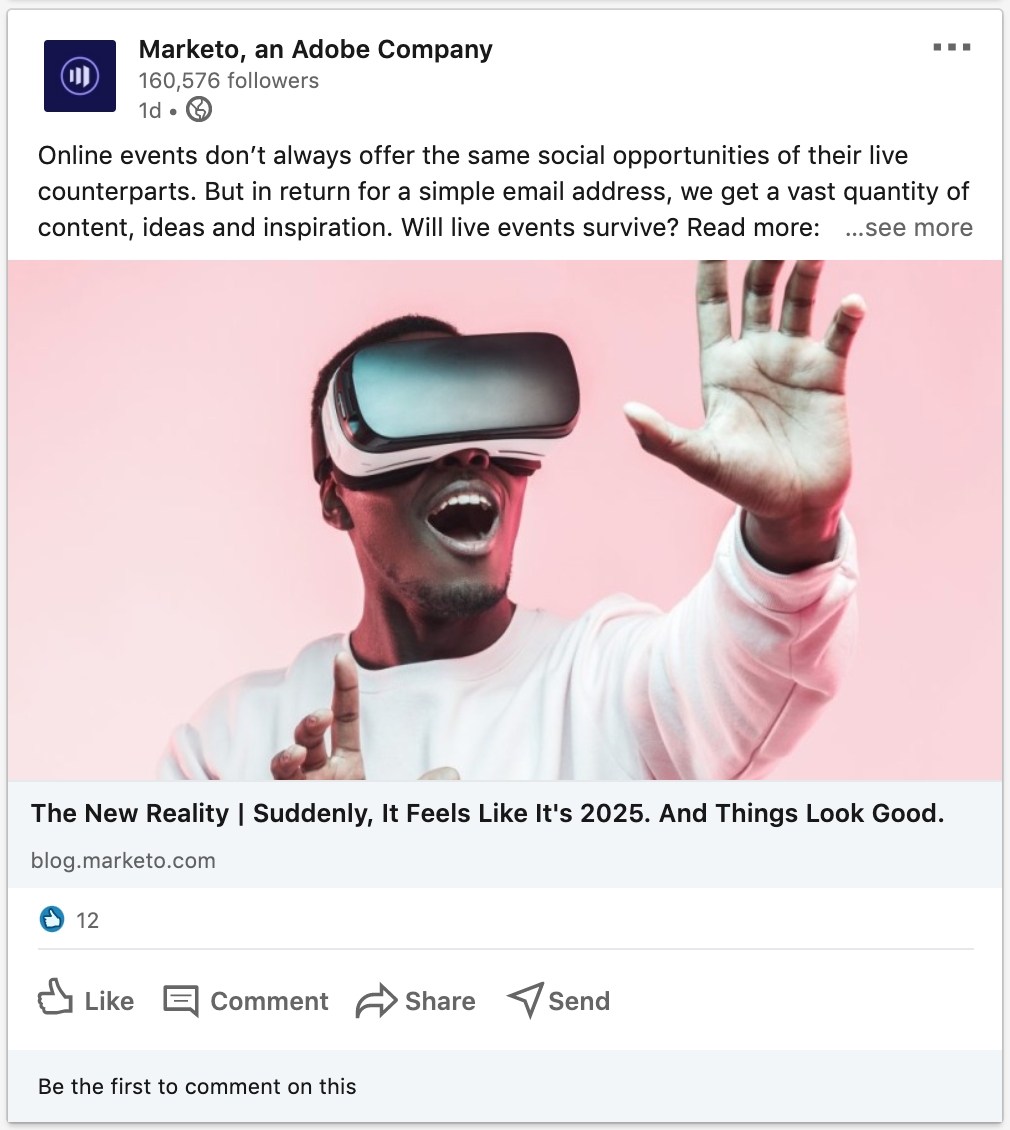 LinkedIn post from Marketo[/caption]
LinkedIn post from Marketo[/caption]Pinterest is another highly visual platform and is perfect for brands with products they’re trying to sell online. However, as a visual search engine, many other types of businesses can do well on this platform, especially for driving traffic to their blog content.
[caption id="" align="aligncenter" width="590"]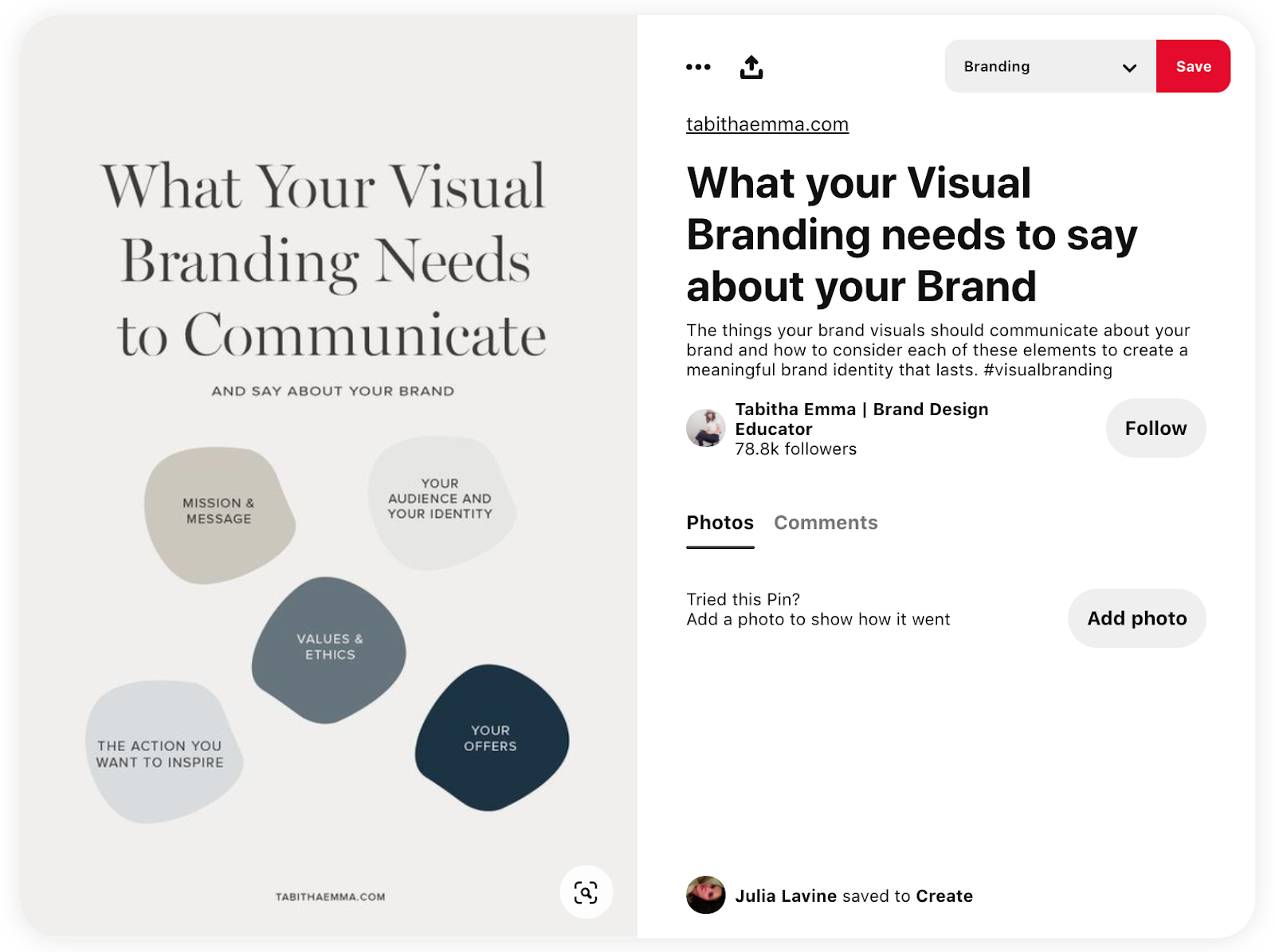 Blog post promoted on Pinterest[/caption]
Blog post promoted on Pinterest[/caption]When you create Pinterest graphics and optimize your pins for blog posts, landing pages, products, services, and more, you’re able to reach a large audience on this platform, regardless of the type of business you’re in.
Other Platforms
There are many other smaller or more niche platforms that you might consider. YouTube is perfect for sharing video content. Snapchat and TikTok could be great ways for your brand to connect with younger generations.
Reddit is another potential platform for your brand to have a presence on relevant subreddit forums, creating and commenting on conversations.
Step 4: Create and share engaging content.
Now that you know where you’re going to be sharing your content, it’s time for the good part – creating your social media content!
While this is definitely the fun part of creating and implementing your social media strategy, it’s important to still be strategic about it. Ensure that your social media content is visually appealing, engaging, and helps you achieve the goals you set in step one.
Here are a few tips to keep in mind while creating your social media content.
Create different content for each platform.
Content that works well on Facebook is not the same as the content that works well on Instagram. While some of your content can absolutely be repurposed and recycled, the bottom line is that you need separate content strategies for each platform.
Use online apps to help you create content.
There are tons of online content creation tools that can help you to put together stellar and unique content for your social media.
Choose a graphic design software to create social media graphics and even infographics. Use an app to create unique video content for social media like boomerangs and time lapses. Create and share branded GIFs.
There are so many online options for creating awesome social media content that will wow your audience and help you stand out from the competition.
Test out different types of content.
There are so many different types of content to create and share. You could try live streaming on Facebook or Instagram, communicating with your audience in real-time. Share video content. Create carousel posts. Put together a theme for your Instagram feed.
Figure out what resonates with your audience by trying out different things via user testing and then stick with what generates the most engagement, traffic, and conversions.
Step 5: Be consistent.
This is key. You can’t create, implement, test, or see success from a social media strategy that you only tinker with every so often.
To really get the most out of your social marketing, you need to stick with it every day. This is why many brands hire an agency to manage their online presence and social media campaigns, ensuring that no stone is left unturned.
While social media management tools are readily available to help you schedule out content so you can create visuals and write copy in batches, there are still so many other aspects of social media that need your attention.
Check your brand’s social media notifications at least a couple of times a day and respond to any comments, replies, or messages to keep up with your social media customer service. Make sure your content publishes perfectly.
And most importantly – remain consistent in sharing content on social media. Not every platform calls for daily posts, but maintaining a schedule that your audience and the social network’s algorithm can rely on is crucial.
Step 6: Interact with your audience.
While some tactics like using hashtags and piggybacking on trending topics can help your content reach a wider audience, there’s still a definite need for your brand to start conversations on its end.
If you want to grow your online following and increase engagement, your brand needs to be doing its own share of social outreach.
Follow users from your target audience. Interact with content shared by users that follow your competition. Be sure to respond to each person who mentions your business online – whether positive or negative.
Building an active online presence is key to growing your following, generating brand awareness on social media, and creating brand loyalty among potential customers.
Step 7: Create an advertising plan.
Alright, we’ve focused exclusively on organic social content up until now. But it’s time to start taking advantage of everything that paid social media advertising has to offer you.
Platforms like Facebook – well, especially Facebook – have such incredible targeting options and a versatile dashboard for creating and sharing your ads that it would be a waste to ignore its potential.
Here are a few key things to include when creating your social advertising strategy.
Determine your advertising budget.
This is the most obvious one. Before putting any further thought into creating your ads plan, you need to know how much you’re able to spend each month on ads.
A great way to pinpoint your advertising budget is to consider how many leads you’re hoping to generate each month. If you’ve run ads in the past, pay attention to your CPC and use that to help you create an overall budget.
If you haven’t run ads in the past, refer to an expert on what the best budget for your brand/industry would be, or test a few ads to see your results and base your future budget on that.
Nail your advertising objectives.
Facebook offers many different types of ads, all based on what your end goal is. You can generate more sales, increase engagement, get Facebook messages, grow Page likes, send traffic to your website, or gather new leads.
[caption id="" align="aligncenter" width="590"]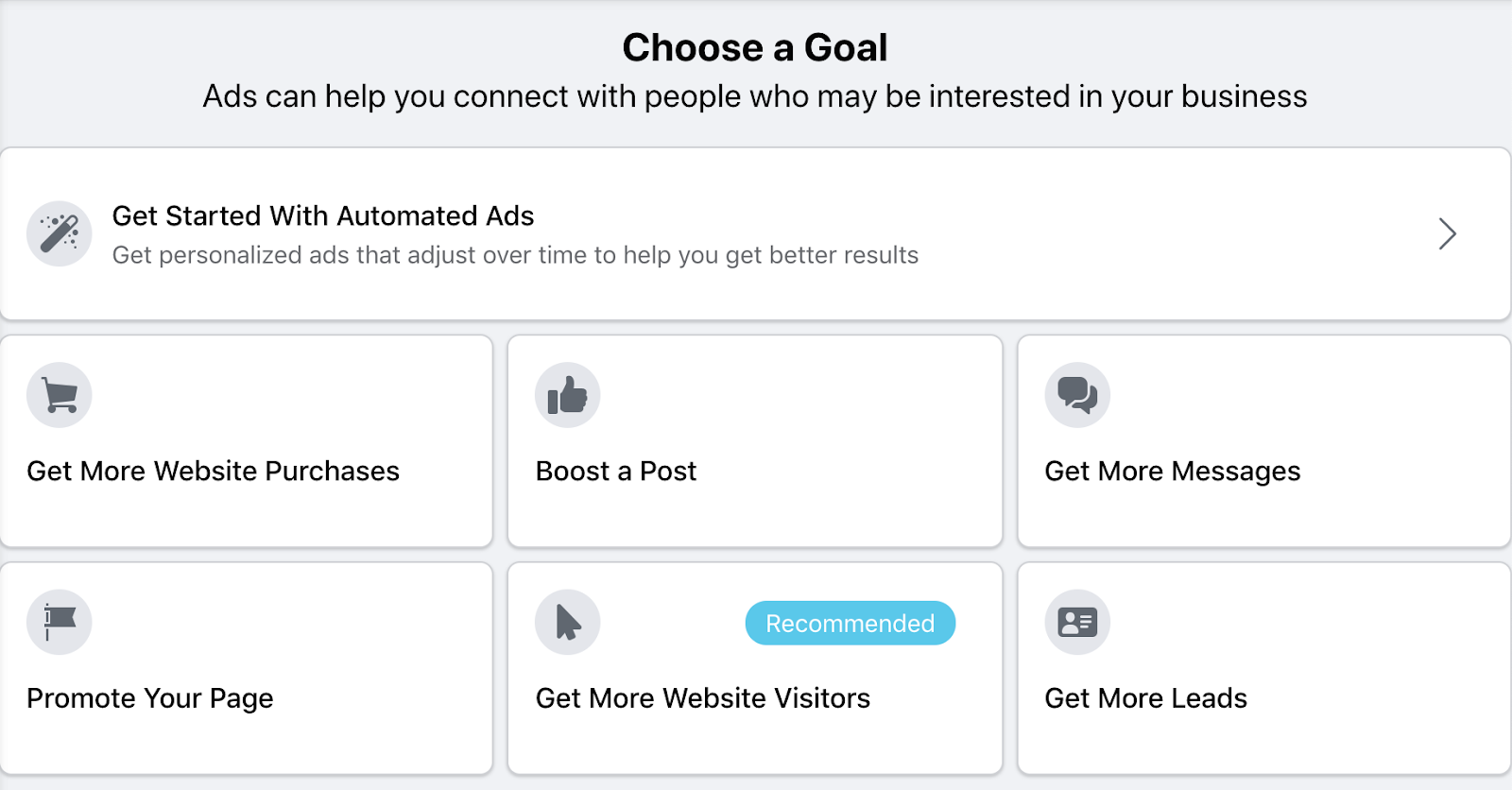 Facebook advertising objectives to choose from[/caption]
Facebook advertising objectives to choose from[/caption]While you can have different goals with your organic social media, this strategy needs to be a bit more direct. What are you willing to pay for? Are you putting your dollars towards new email addresses to add to your CRM or to more traffic to a certain landing page?
Nailing down your objective(s) for social media advertising needs to be taken care of before you can start creating ad copy and visuals.
Put together your ad creative.
Ad creative refers to both visuals and copy. While on many platforms, your visuals tend to be more important than your copy or captions, you want to put a major emphasis on both when creating ads.
Determine whether you’re designing graphics, putting together a video or promoting a landing page in your ad. Then use your copy to entice and engage your audience.
We’ve put together a monster post with 163 epic Facebook ad examples to give you a good idea of what can really grab your audience’s attention.
Step 8: Analyze and assess your results.
Once you finalize and implement your social media strategy, the last step is to analyze your progress and determine if you’re seeing the return you’re looking for.
There are many different social media analytics tools to help make this step easier for you so that you can quickly pull reports, check out your engagement, and determine where you might need to make changes in your strategy.
The most important takeaway from this step is that no social media strategy is a “set it and forget it” course. You will always need to test, analyze, and adapt your tactics across your social media networks to make sure you’re getting the best results possible.
Be sure to check in with your Google analytics as well to see how much traffic your website is bringing in from social media. You can also set up goals that will help you to track website behavior and conversions from your social media referrals.
Create Your Social Media Marketing Strategy Today
Ready to create and nail your social media marketing plan? Choose the right social channels, create quality content, and engage authentically with your audience.
While it can certainly take a lot of work, it’s not hard to build a genuine social media presence that resonates with your audience and makes them want to buy from you. You just have to get started.